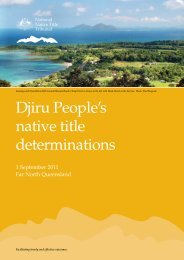Biodiveristy_State of Environment report - Mission Beach Cassowaries
Biodiveristy_State of Environment report - Mission Beach Cassowaries
Biodiveristy_State of Environment report - Mission Beach Cassowaries
- No tags were found...
You also want an ePaper? Increase the reach of your titles
YUMPU automatically turns print PDFs into web optimized ePapers that Google loves.
ResponsesGreat Barrier Reef Marine Park ZoningSignificant changes occurred to the protection <strong>of</strong> the GreatBarrier Reef in 2003. The Marine Park Zoning Plan wasradically altered to increase the area protected, and toensure that areas representing all types <strong>of</strong> biodiversity onthe Reef were included. These representative areas includeall the differing habitats and species communities <strong>of</strong> theReef. A minimum <strong>of</strong> 20% <strong>of</strong> each type <strong>of</strong> representativearea will be protected by ‘no-take’ green zoning whichprevents impacts from fishing or other extractiveutilisation. Overall, approximately one-third <strong>of</strong> the Reef isnow protected. The zoning plan for the region adjacent tothe Shire can be seen at http://www.reefed.edu.au/rap/pdf/mpz_07.pdf.DPI&F are responsible for patrolling the marine parks, andcontrolling the commercial and recreational fisheries.QPWS are also employing extra staff to manage the<strong>of</strong>fshore islands, and to help to patrol the Shire's greenzones.Nutrients and SedimentsWork towards reducing impact from nutrients andsediments is based upon land management practiceonshore. These practices are examined in the LandManagement chapter, mainly in section 7.ShippingReef CRC have initiated research into organismsintroduced to marine environments. The primary goal <strong>of</strong>this work will be to identify the distribution <strong>of</strong> introducedorganisms, and identification <strong>of</strong> high-risk taxa. The PortsAuthority has response plans in place should there be anyrelease <strong>of</strong> pollution from a shipping accident.3.1.3 Introduced SpeciesTilapiaTwo species <strong>of</strong> Tilapia fish have been introduced towaterways in Queensland. The Shire has Tilapia mariae , afish which has achieved extraordinary success in theShire's waterways, being an aggressive species that willchase other fish out <strong>of</strong> territories it establishes. Thisexacerbates its effect <strong>of</strong> competing with native fish forfood. Tilapia are omnivorous, mainly eating plants andalgae, but will also eat insects and other food."Tilapia are sexually mature at three years <strong>of</strong> age or less inFigure 3.1.3 - Black mangrove cichlid (Tilapia mariae)Source DPI&F Website (2005a)favourable conditions. They are able to reach sexualmaturity at small sizes in poor conditions or when they areovercrowded. This is known as 'stunting' and results inlarge populations <strong>of</strong> mature fish with small body sizes.…Tilapia have successfully invaded and dominated manyaquatic habitats due to their highly efficient reproductivestrategy, simple food requirements and their ability to livein a variety <strong>of</strong> conditions. Unlike many native freshwaterfishes, tilapia are able to retreat downstream into highlysaline waters during drought and move back upstream whenconditions improve. They affect native species whencompeting for habitat and food, behaving aggressively anddisturbing plant beds when building nests." (DPI&FWebsite, 2005a).Because Tilapia are hardy fish, resistant to low oxygenlevels and salinity, they are <strong>of</strong>ten found in cane drainsaround the Shire's waterways.Movement <strong>of</strong> Tilapia is restricted by the DPI&F. However,this has not stopped the fish from spreading into otherrivers in the region."It is illegal to possess, rear, sell or buy Tilapia. It is also an<strong>of</strong>fence to release Tilapia into Queensland waterways or touse them as bait, live or dead. Penalties up to $150 000apply" (DPI&F Website, 2005a). The fish cannot be used asbait because <strong>of</strong> the risk that eggs may infest otherwaterways.ResponseThere is no control response currently formulated to dealwith Tilapia. These fish are an aquaculture fish in othercountries - it has been suggested that placing an economicvalue on the fish may encourage control. However, thismight encourage people to introduce them to un-infestedareas. It is possible for individuals to catch large numbers<strong>of</strong> the fish with minimal effort in a day. A strategy <strong>of</strong> thisnature would have to be rigorously licensed and controlled.'Muling' the fish by introducing genetically modified malescapable <strong>of</strong> fathering only more male <strong>of</strong>fspring, is a potentialsolution requiring research.Rec: DPI&F establish a control and eradication program forTilapia - DPI&F3.2 Aquatic Flora3.2.1 SeagrassesSeagrasses have undergone a worldwide decline, furtheraffecting the species they support and ultimately industriessuch as fisheries. Johnstone Shire has significant seagrassareas, it is important that these areas are conserved andprotected from adverse human impacts.Seagrass is important habitat for juvenile prawns, finfish,turtles, and dugong, and hence are an important primarytrophic layer for the ecosystems they support. Sea grassbeds are considered an important cultural food source areaby the Ma:mu people.59



